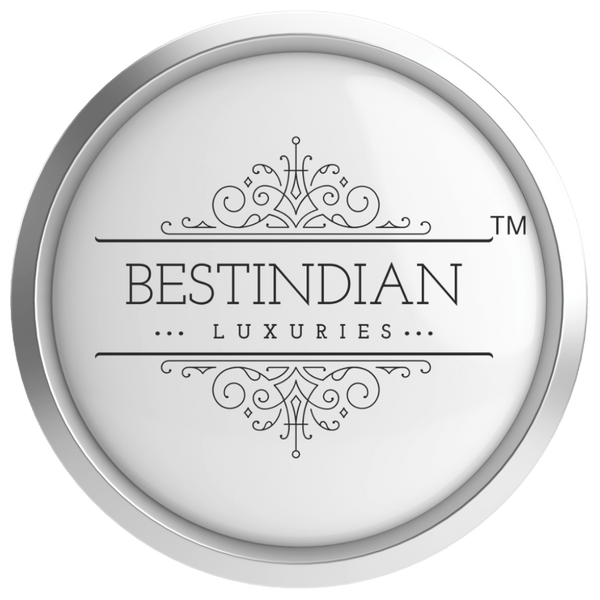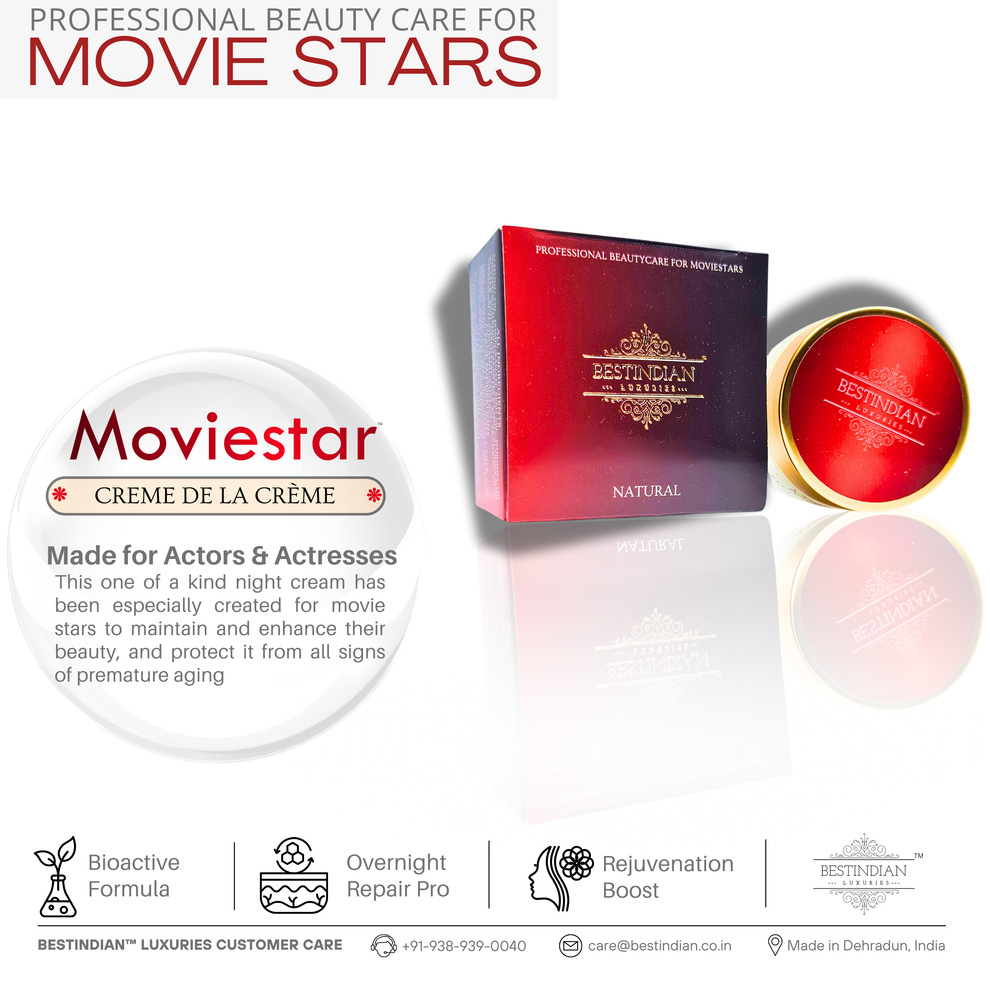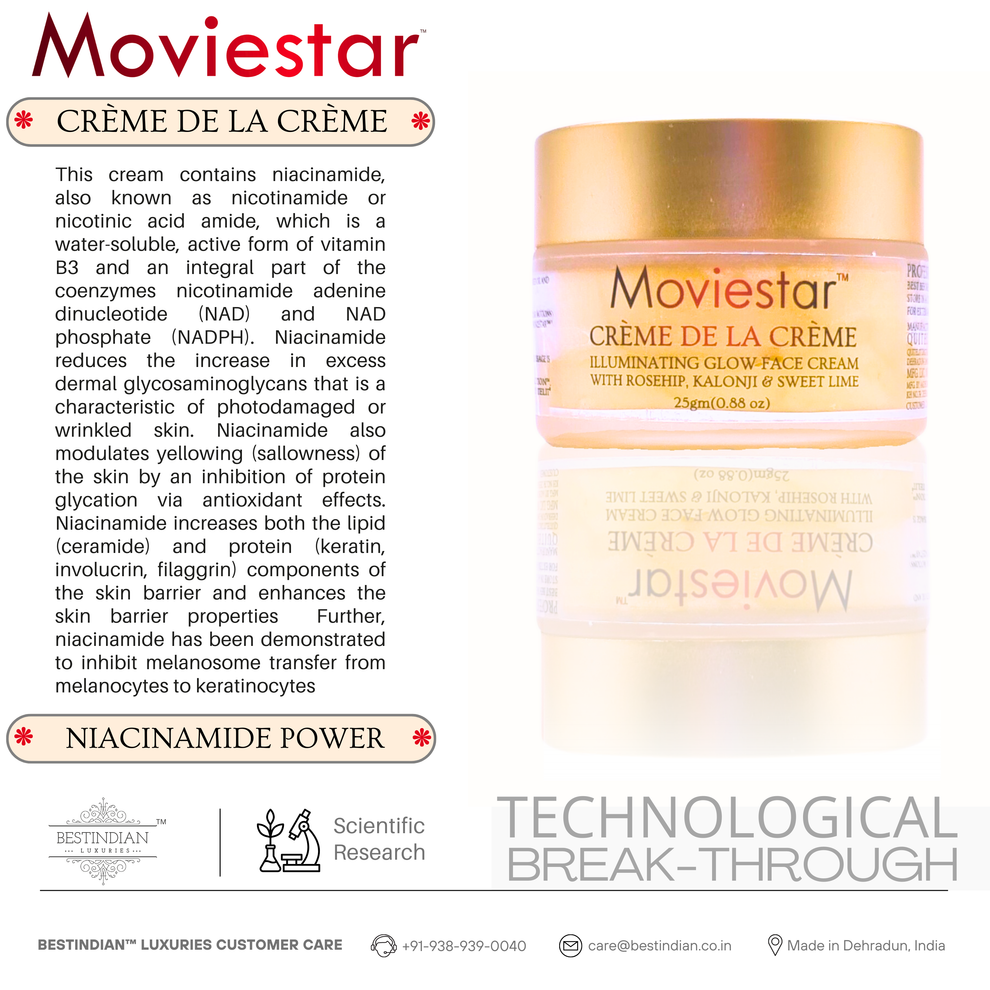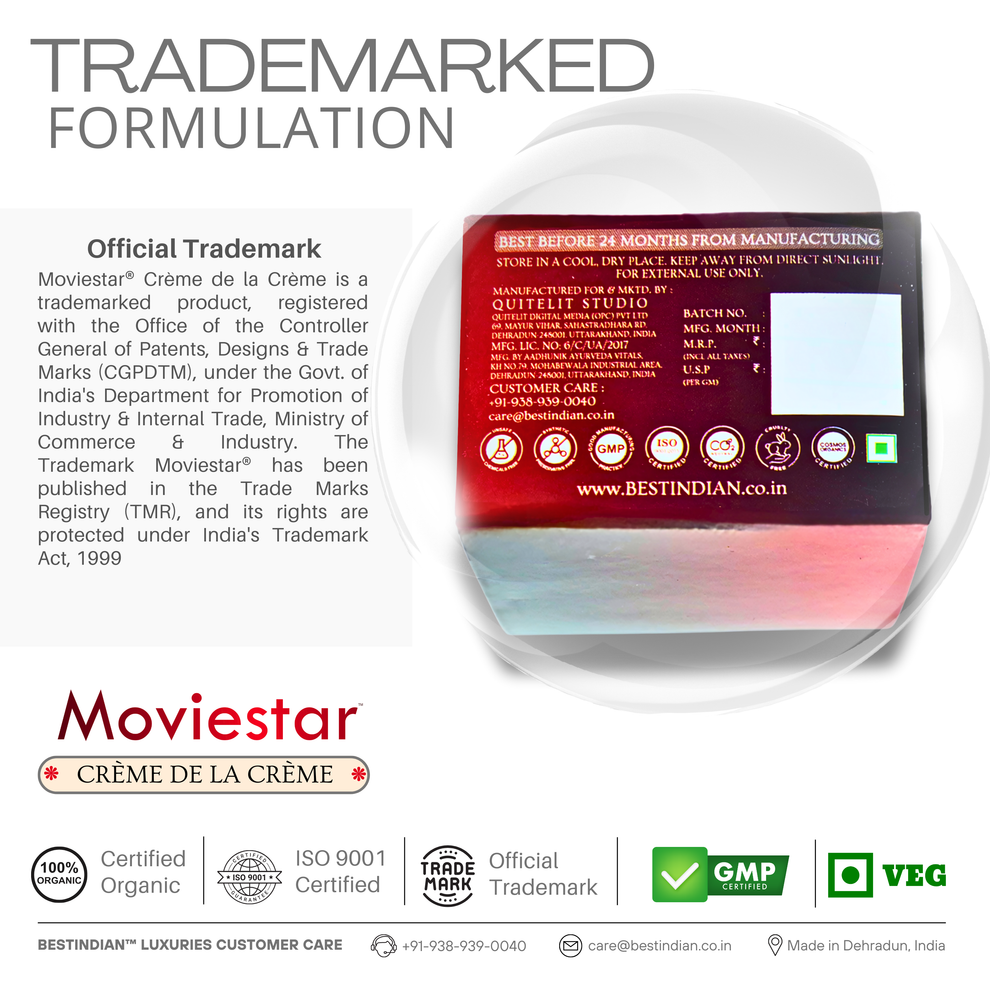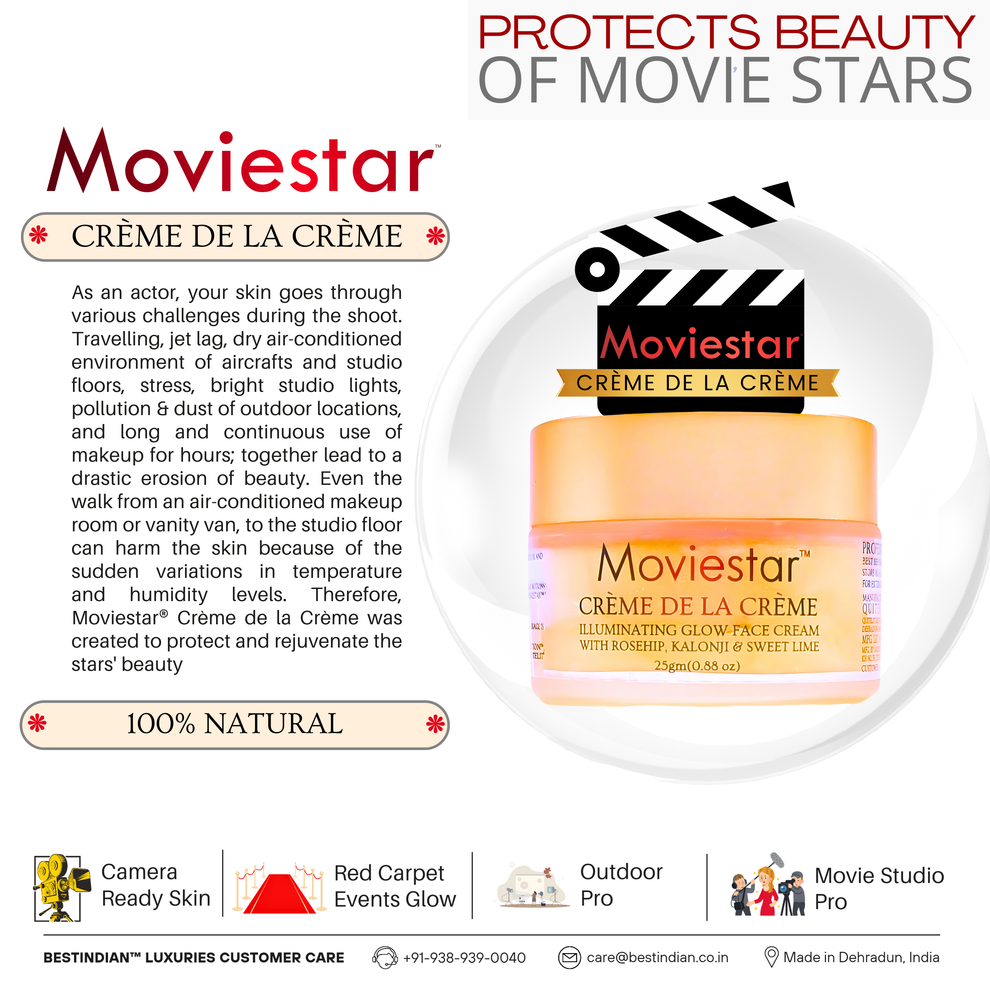BestIndian
Moviestar™ Crème De La Crème: The Best Indian Night Cream for Overnight Repair & Youthful Glow
Moviestar™ Crème De La Crème: The Best Indian Night Cream for Overnight Repair & Youthful Glow
Couldn't load pickup availability
Wake up to your best skin ever. The Moviestar™ Crème De La Crème is a luxurious, anti-aging night cream for glowing skin, formulated for the unforgiving eye of the lens—from phone selfies to 8K cinema. Powered by natural retinol alternatives like Provitamin A from Rosehip and Kalonji, this rich Ayurvedic formula works in synergy with your skin’s nightly repair cycle. It deeply hydrates, supports natural collagen, and visibly reduces the appearance of wrinkles and dark spots, revealing a smoother, firmer, and flawlessly camera-ready complexion by morning.
An intense overnight repair cream with plant-based retinols to restore a firm, radiant, movie-star glow.
Trust Signal
- ⚜️ 100% Natural Formula
- ⚜️ Certified Organic Ingredients
- ⚜️ Cruelty-Free
- ⚜️ Made in the Himalayas
Please Note: Conscious Archive Item (60% Off)
- Manufacturing Date: January 2024
- Best Before: January 2026
- This item is part of our Conscious Archive Sale and is offered at an exceptional 60% discount due to its approaching best before date. It is final sale.

CRÈME DE LA CRÈME
Share










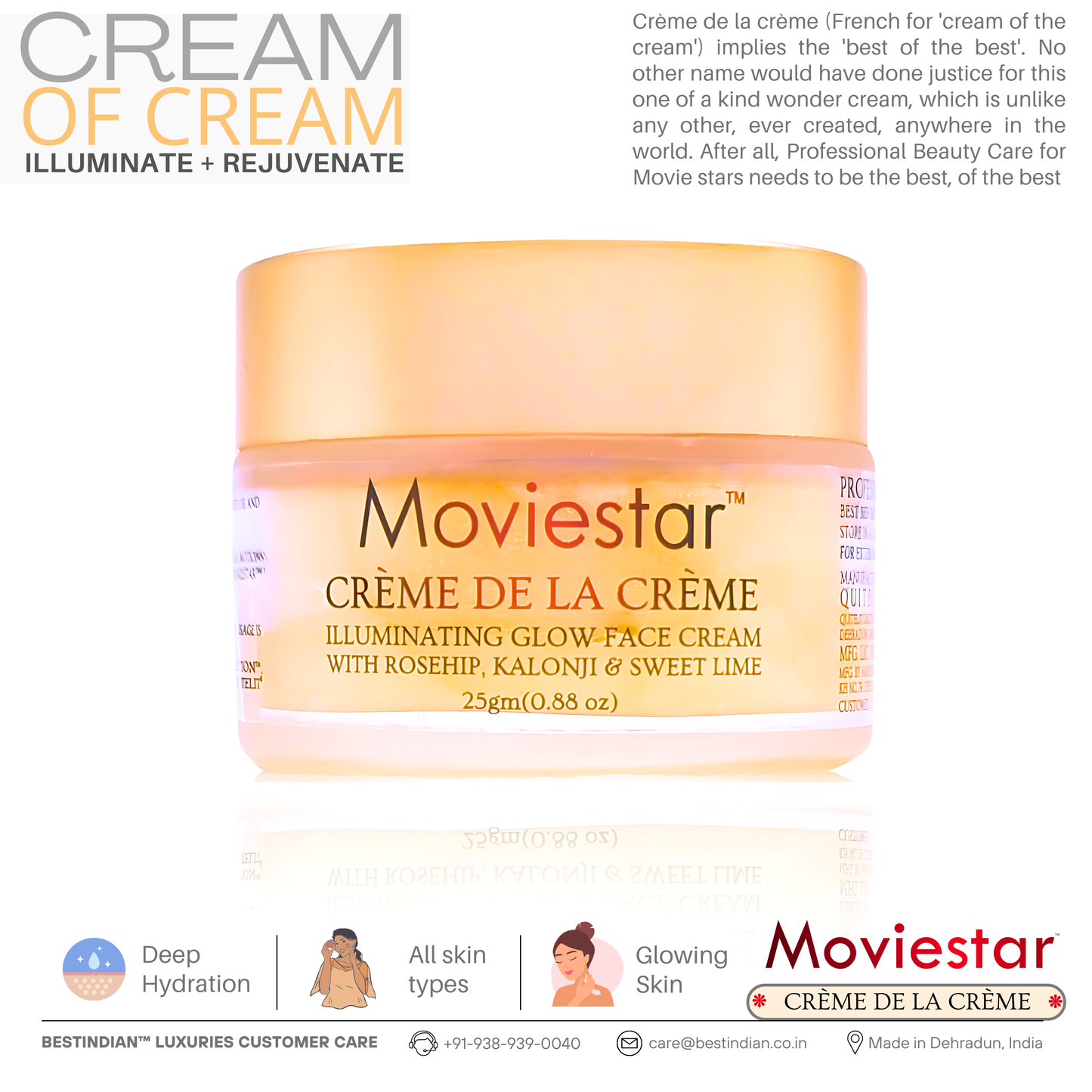




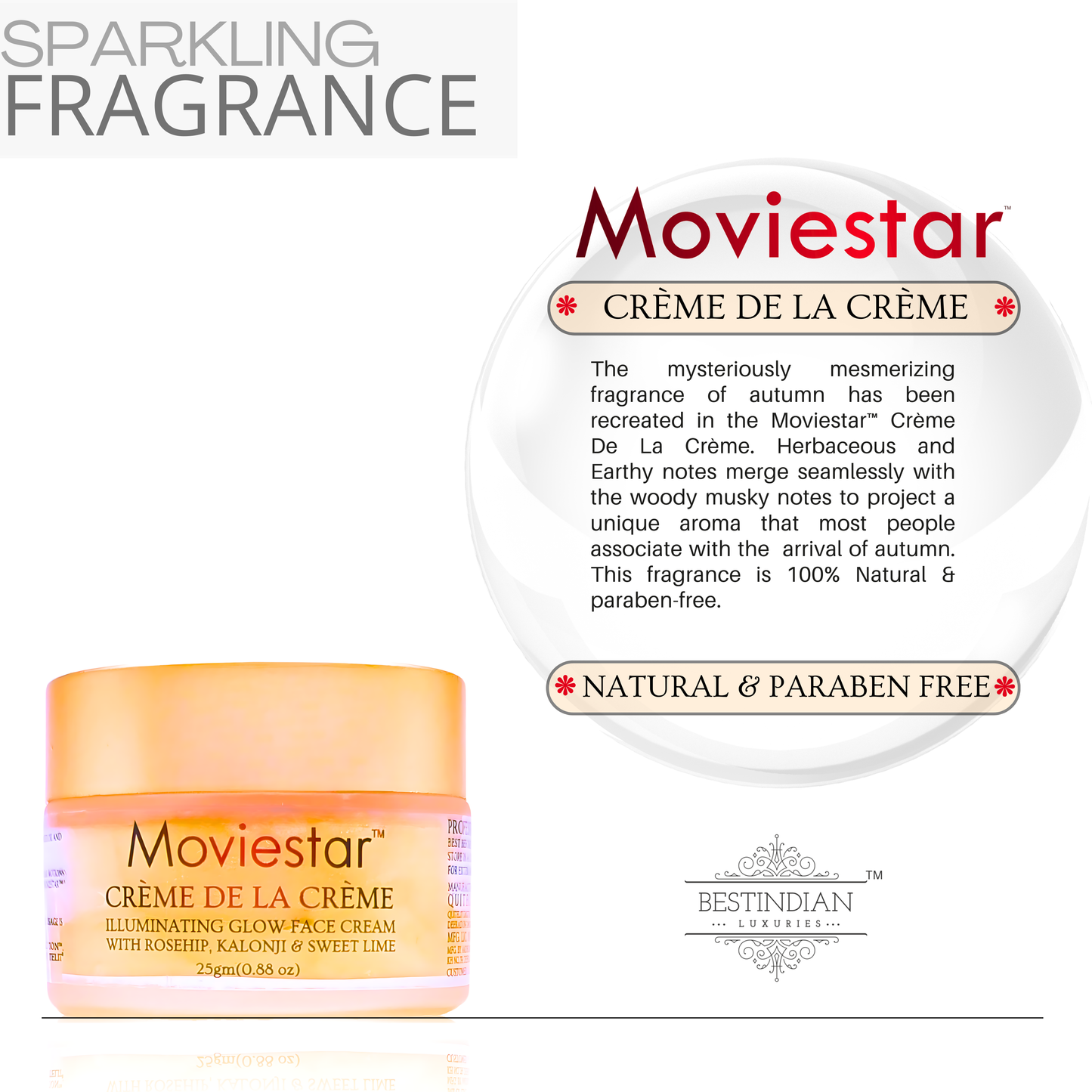



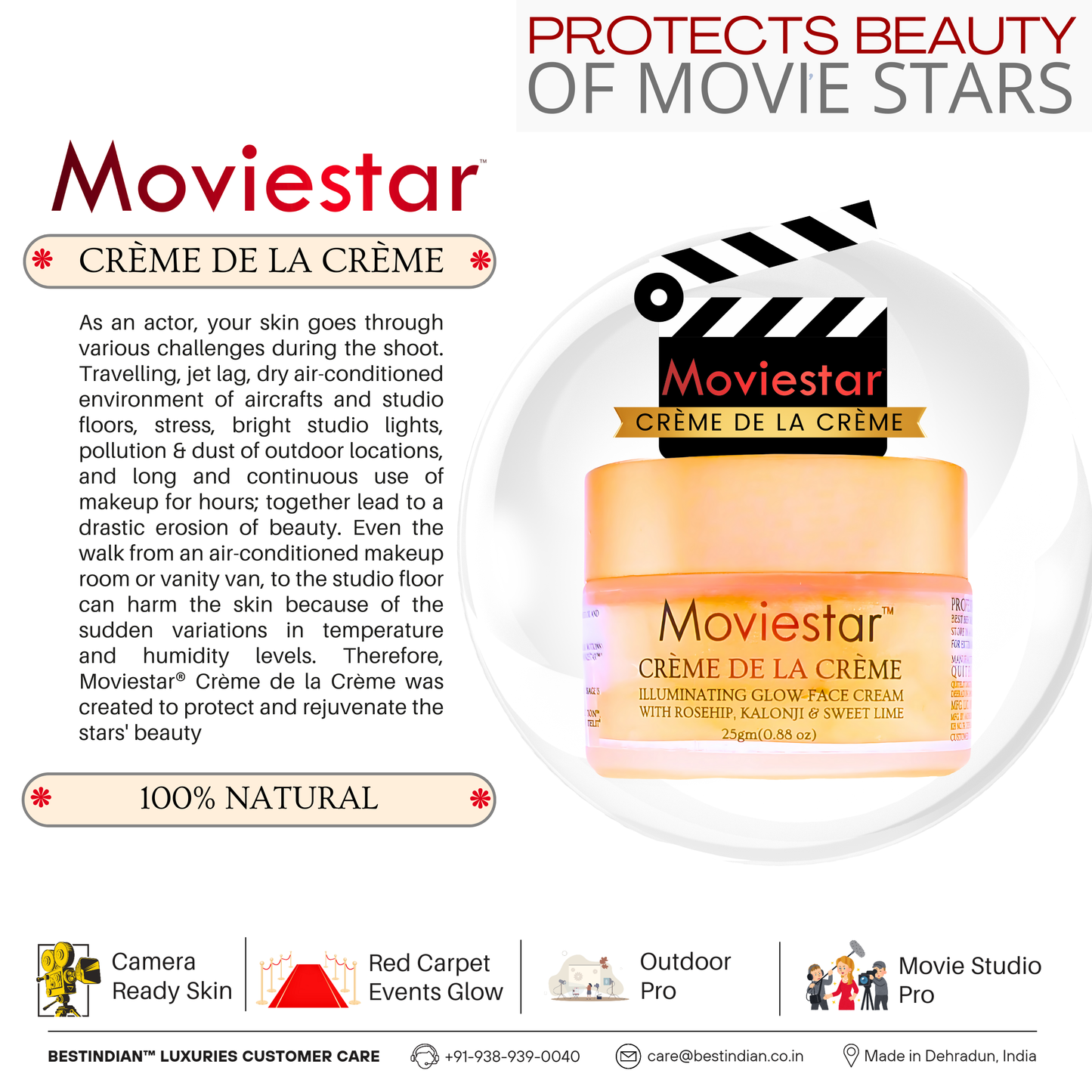

BESTINDIAN LUXURIES
The Finer Details
Why You’ll Love It
- ⚜️ Visibly Reduces Fine Lines & Wrinkles: Our natural retinol alternative (Provitamin A) and collagen-supporting botanicals work overnight to smooth the appearance of wrinkles and improve skin elasticity.
- ⚜️ Restores a Luminous, Even Tone: Actively diminishes the look of dark spots and hyperpigmentation, revealing a brighter, clearer, and more consistent complexion.
- ⚜️ Provides Intense Overnight Hydration: Rich emollients like Shea Butter and Watermelon Seed Oil deeply moisturize and replenish the skin’s protective lipid barrier to prevent dryness.
- ⚜️ Calms and Soothes Stressed Skin: Powerful anti-inflammatory ingredients help to reduce the appearance of redness and calm irritation from daily environmental stressors.
- ⚜️ Delivers a Camera-Ready Glow: The formula supports your skin's natural renewal process, removing the look of dullness and fatigue so you wake up to a smooth, radiant glow.
All Benefits
This intense overnight treatment is formulated to deliver a comprehensive array of benefits, working in synergy with your skin's natural nighttime repair cycle.
Overnight Rejuvenation & Radiance
- Reduces the Look of Fatigue: Works overnight to diminish the appearance of dullness, revealing a fresher, more revitalized complexion by morning.
- Promotes an Illuminating Glow: Supports the skin's natural surface renewal process, helping to unveil a visibly brighter and more radiant appearance.
- Evens Skin Tone & Appearance: Helps to reduce the look of blemishes and dark spots for a more consistent and mesmerizing complexion.
Anti-Aging & Firming Action
- Improves the Appearance of Firmness: Formulated with ingredients known to support collagen, helping to improve skin elasticity for a firmer, more lifted look.
- Smooths Fine Lines & Wrinkles: Intensely moisturizes to help plump the skin's surface, reducing the visible appearance of fine lines and wrinkles.
Deep Hydration & Soothing
- Provides Intense Moisturization: Deeply nourishes and hydrates the skin, replenishing essential nutrients while you sleep.
- Soothes and Calms: Helps to reduce the appearance of redness and calm irritated skin overnight.
Purifying & Protective Care
- Helps Purify the Skin's Surface: Gently clarifies the skin and helps balance oils, promoting a clearer-looking complexion.
- Fights Environmental Stressors: Rich in antioxidants that help neutralize the damaging effects of free radicals from daily environmental exposure.
- Creates a Protective Barrier: Forms a breathable layer on the skin's surface to lock in moisture and protect it overnight.
Your Ritual & Care
The Nightly Rejuvenation Ritual
Make this the final, most restorative step of your evening skincare routine.
- Prepare: Begin with a thoroughly cleansed and toned face. Your skin should be receptive and ready for nourishment.
- Warm: Dispense a small, pea-sized amount of the Crème De La Crème onto your fingertips. Gently rub your fingertips together to warm the cream, activating its potent botanicals.
- Apply: Gently press the cream onto your face, neck, and décolletage. Massage using upward, sweeping motions until it is fully absorbed, allowing the rich emollients to deeply moisturize your skin.
The Golden Rule of Night Creams
This formula is specifically designed to work in synergy with your skin's peak nighttime repair cycle. Applying it before bed allows the bioactive compounds to support cell renewal, replenish nutrients, and repair daily damage while you sleep.
Ideal For
- ⚜️ All skin types, and suitable for both women and men.
- ⚜️ Professionals, actors, and actresses looking to counteract the visible effects of heavy makeup, stress, and environmental aggressors.
- ⚜️ Individuals wanting to address the visible signs of aging, such as the appearance of dullness, fine lines, and uneven skin tone.
- ⚜️ Anyone desiring an intense overnight moisturization and rejuvenation treatment to wake up with a glowing, mesmerising complexion.
Product Care & Safety
- ⚜️ Store in a cool, dry place away from direct sunlight.
- ⚜️ A patch test on a small area of skin is recommended prior to first use.
- ⚜️ For external use only. Best before 24 months from manufacturing.
Complete Your Moviestar™ Ritual
- ⚜️ Step 1: Cleanse with Moviestar™ Makeup Remover Cream for Radiance - Gently melt away all traces of makeup while nourishing the skin.
- ⚜️ Step 2: Prep Skin with Moviestar™ pH Balancing Toner - Restore skin’s equilibrium, boost hydration— while prepping skin to better absorb cream.
Fragrance
An Olfactory Profile: The Scent of Autumn
The aroma of Moviestar™ Crème De La Crème is a unique, sophisticated composition that evokes the comforting and luxurious feeling of a crisp autumn evening. This 100% natural, paraben-free fragrance is created by combining the following pure botanical extracts.
Rosehip
The journey begins with the deep, complex note of Rosehip. It presents a sophisticated blend of earthy and herbaceous tones, brightened by a subtle floral-fruity character.
Kalonji (Nigella Sativa)
At the heart is the intriguing aroma of Kalonji. It adds a pleasant, warm depth with its unique fruity-woody and musky character.
Sweet Lime
The fragrance finishes with a whisper of Sweet Lime, which cuts through the richness with a fresh, lively, and energetic citrus note, leaving the senses feeling clean and uplifted.
Ingredient Transparency
Our Promise of 100% Transparency
We believe you have a right to know exactly what you are putting on your skin. BestIndian™ practices radical transparency and guarantees that no other ingredient, apart from those listed below, has been used in this 100% natural and synthetic chemical-free luxury formula.
Full Ingredient List (INCI)
Rosehip (Rosa Canina) Seed Oil, Watermelon (Citrullus Lanatus) Seed Oil, Shea Butter (Butyrospermum Parkii), Kalonji (Nigella Sativa) Seed Oil, Apple (Pyrus Malus) Seed Oil, Fennel (Foeniculum Vulgare) Essential Oil, Sweet Lime (Citrus Limetta) Essential Oil.
Ingredient Deep Dive
Rosehip Seed Oil (Rosa Canina): The Natural Retinol Alternative
Celebrated for its high concentration of Provitamin A, carotenoids, and essential fatty acids. This botanical powerhouse is traditionally used to improve the appearance of skin texture, reduce the look of fine lines and scars, and promote a brighter, more even-toned complexion. It is the cornerstone of our gentle, effective anti-aging approach.
Kalonji Oil (Nigella Sativa): The Ancient Purifier
Also known as Black Cumin seed oil, Kalonji is a legendary ingredient in Ayurvedic and Middle Eastern traditions. Rich in antioxidants and vitamins A, D, E, and K, it is renowned for its purifying and soothing properties, helping to calm irritated skin and combat the environmental stressors that lead to a dull, uneven appearance.
Shea Butter (Butyrospermum Parkii): The Ultimate Moisturizer
A superior emollient that provides intense, lasting moisture without clogging pores. Shea Butter is rich in fatty acids and vitamins that are essential for fortifying the skin’s natural protective barrier. This helps to lock in hydration, improve the look of elasticity, and leave the skin feeling exceptionally soft and supple.
Watermelon Seed Oil (Citrullus Lanatus): The Lightweight Detoxifier
A light, fast-absorbing oil packed with linoleic acid and antioxidants. It helps to dissolve excess sebum and impurities on the skin's surface, promoting a clearer, less congested look. Its lightweight nature makes it a perfect hydrator for all skin types, leaving the skin feeling balanced and refreshed.
Apple Seed Oil (Pyrus Malus): The Collagen Supporter
A luxurious oil known for its high concentration of fatty acids and compounds that support the skin's natural collagen network. By helping to protect the skin's underlying structure, it improves the appearance of firmness and elasticity, contributing to a plumper, more youthful look.
Sweet Lime Essential Oil (Citrus Limetta): The Radiance Booster
This bright, energetic oil is a natural source of Vitamin C and flavonoids. It is traditionally used in skincare to help brighten the complexion and reduce the appearance of dark spots and blemishes. Its crisp scent also provides an uplifting, rejuvenating sensory experience.
Fennel Essential Oil (Foeniculum Vulgare): The Toning Agent
With its clean, herbaceous aroma, Fennel essential oil is known for its toning and firming properties. It helps to improve the skin's texture, giving it a smoother and more refined appearance while providing additional antioxidant protection.
Formulated Without
Parabens, Sulfates, Phthalates, Silicones, Synthetic Fragrances, Mineral Oil, and Chemical Preservatives.
Frequently Asked Questions
How is this different from a standard anti-aging cream?
⚜️ While many creams focus on a single ingredient, the Moviestar™ Crème De La Crème is a multi-action formula. It combines a natural retinol alternative with potent antioxidants and barrier-supporting lipids to address signs of aging, environmental damage, and dehydration all at once.
Does this cream contain synthetic Retinol?
⚜️ No. Our 100% natural formula provides Provitamin A (a natural retinol alternative) from Rosehip and other botanicals. This offers the visible benefits of smoother, firmer-looking skin without the harshness, redness, or peeling associated with synthetic retinoids.
Is this cream suitable for oily or acne-prone skin?
⚜️ Yes. While intensely moisturizing, the cream is formulated with non-comedogenic oils and purifying botanicals. It helps to balance the skin's surface oils, making it suitable for all skin types, including those prone to oiliness.
Can men use this night cream?
⚜️ Absolutely. It is formulated as a unisex product for all skin types and is particularly effective at repairing daily environmental damage that affects everyone's skin.
How does this cream help with uneven skin tone and dark spots?
⚜️ The formula is rich in natural antioxidants and ingredients like Niacinamide, which are known to improve the skin's surface renewal process. With consistent use, this helps to diminish the appearance of dark spots and hyperpigmentation for a brighter, more even-toned complexion.
How long until I see results?
⚜️ Visible hydration and a refreshed glow can often be seen from the first few mornings. Deeper results, such as a reduction in the appearance of fine lines and pigmentation, typically become more noticeable after 6-8 weeks of consistent nightly use.
Is the cream heavy or greasy?
⚜️ The cream has a rich, luxurious texture but is engineered to be fast-absorbing. It melts into the skin to form a silky, non-greasy finish that feels comfortable and breathable overnight.
The Science & Sensory Experience
The Science & Sensory Experience
Healthy skin thrives when its protective acid mantle is in balance. The Moviestar™ Crème De La Crème is a rich, bioactive formula designed to support this natural equilibrium. It delivers potent antioxidants and phytochemicals from its key botanicals deep into the skin's surface layers. The sensory experience is one of pure luxury—a rich, nourishing cream with a unique, comforting aroma of Rosehip and Kalonji that transforms your nightly routine into a restorative ritual.
The Science of Overnight Rejuvenation
Your skin's outermost layer, the epidermis, is a sophisticated barrier designed to lock in moisture while protecting you from the environment. This barrier is maintained by a delicate lipid (oil) coating called the acid mantle. Daily exposure to cleansers, pollution, and UV radiation can strip these lipids, weakening the barrier and leading to moisture loss, irritation, and visible signs of aging.
The Moviestar™ Crème De La Crème is engineered to work in harmony with your skin's natural nighttime repair cycle to address this daily damage.
Our Multi-Bioactive Approach
⚜️ Supports the Skin's Protective Barrier
A healthy barrier is crucial for flexible, hydrated skin. When the barrier is compromised, water escapes more easily, accelerating the cycle of dryness and damage. Our cream delivers rich emollients that supplement the skin's natural lipids, creating a breathable layer that helps lock in moisture overnight and supports the skin's own barrier-restoration process.
⚜️ Combats the Appearance of Photoaging
Daily sun exposure creates unstable molecules called free radicals, which trigger enzymes that degrade your skin's natural collagen network. This leads to the visible signs of photoaging, such as the appearance of wrinkles and a loss of firmness. Our formula is a powerhouse of antioxidants, like those from Rosehip and Kalonji, that help neutralize these free radicals.
⚜️ Visibly Improves Skin Tone & Texture
This formula features Niacinamide (a form of Vitamin B3), a renowned skincare ingredient. Clinical studies on Niacinamide have shown it helps to significantly improve the skin’s appearance by reducing the look of fine lines, wrinkles, red blotchiness, and hyperpigmented spots, while also improving elasticity.
⚜️ Promotes a Firm, Youthful Look
Our cream is formulated with ingredients known to support the skin's natural collagen pathways. This includes botanicals rich in Provitamin A and Niacinamide, which helps improve the appearance of skin elasticity and firmness, contributing to a plumper, more youthful look.
⚜️ Brightens & Evens the Complexion
To address the look of dark spots and uneven tone, our formula contains ingredients that help inhibit the activity of tyrosinase—the enzyme involved in melanin production. This helps to promote a brighter, clearer, and more luminous complexion.
Star Ingredients
-

Rosehip
⚜️ Rosehip Seed Oil: A powerhouse of natural Provitamin A, this oil is celebrated for its ability to improve the appearance of skin texture, fine lines, and pigmentation.
- Brightens and helps even overall skin tone.
- Provides potent antibacterial and anti-inflammatory benefits.
- Helps improve skin elasticity and firmness.
Its bioactive compounds include flavonoids, tannins, anthocyanin, phenolic compounds, fatty oil, organic acids, etc. Rosehip contains carotenoids, which help treat early signs of aging like fine lines, wrinkles, blemishes, acne scars, etc., by creating new skin cells.
-

Kalonji
⚜️ Rich in antioxidants, this ancient oil is known for its purifying and soothing properties, helping to maintain a clear and calm complexion.
- Offers antimicrobial support against acne-causing bacteria.
- Helps to calm and reduce facial redness.
Its non-comedogenic nature keeps pores clear. Nigella sativa seeds are a storehouse of anti-aging antioxidants, besides fat-soluble vitamins like A, D, E and K, which slow down the signs of aging, fight pigmentation and also treat a variety of skin conditions like eczema, psoriasis and acne. Myristic acid, vitamins, alkaloids, coumarins, saponins, flavonoids, fixed oils and phenolics are main bioactive compounds.
-

Sweet Lime
Citrus limetta contains polyphenols such as hesperetin, flavanones, naringenin, and chlorogenic acid, etc. These bioactive compounds act as natural moisturizer, and help in clearing out pigmentation, acne, blemishes, etc. The vitamin C aids in collagen production, promoting healthy and youthful skin; and helps combat the effects of oxidative stress

Trust & Transparency
The BestIndian™ Promise
At BestIndian™, we believe luxury is defined by authenticity & efficacy. Our philosophy marries the timeless wisdom of Ayurveda with the precision of modern science. We disclose all ingredients used in every product we make, because your trust is our most valued asset.
⚜️
Our Promise: Formulated with 100% natural and certified organic ingredients. Always free from preservatives, parabens, and sulfates. Vegetarian and vegan friendly. No hidden ingredients.
⚜️
Our Certifications: Manufactured in a GMP, ISO & COSMOS Organic certified, carbon-neutral, cruelty-free facility amidst pollution-free environment of the Himalayas in Dehradun, India
OUR BRANDS
-

Moviestar™ – Luxury Ayurvedic Skincare brand by BestIndian™
Luxury skincare designed for professional actors. Moviestar™ by BestIndian™ is a premium...
-

GlowPotion™ – Natural Ayurvedic Skincare brand by BestIndian™
The pinnacle of beauty is a complexion that requires no makeup to...
-

The Elixir of Youth™ Collection for Anti-Aging & Wrinkle Repair
Welcome to Elixir of Youth™- scientifically created, high-performance Ayurvedic formulations designed by...
